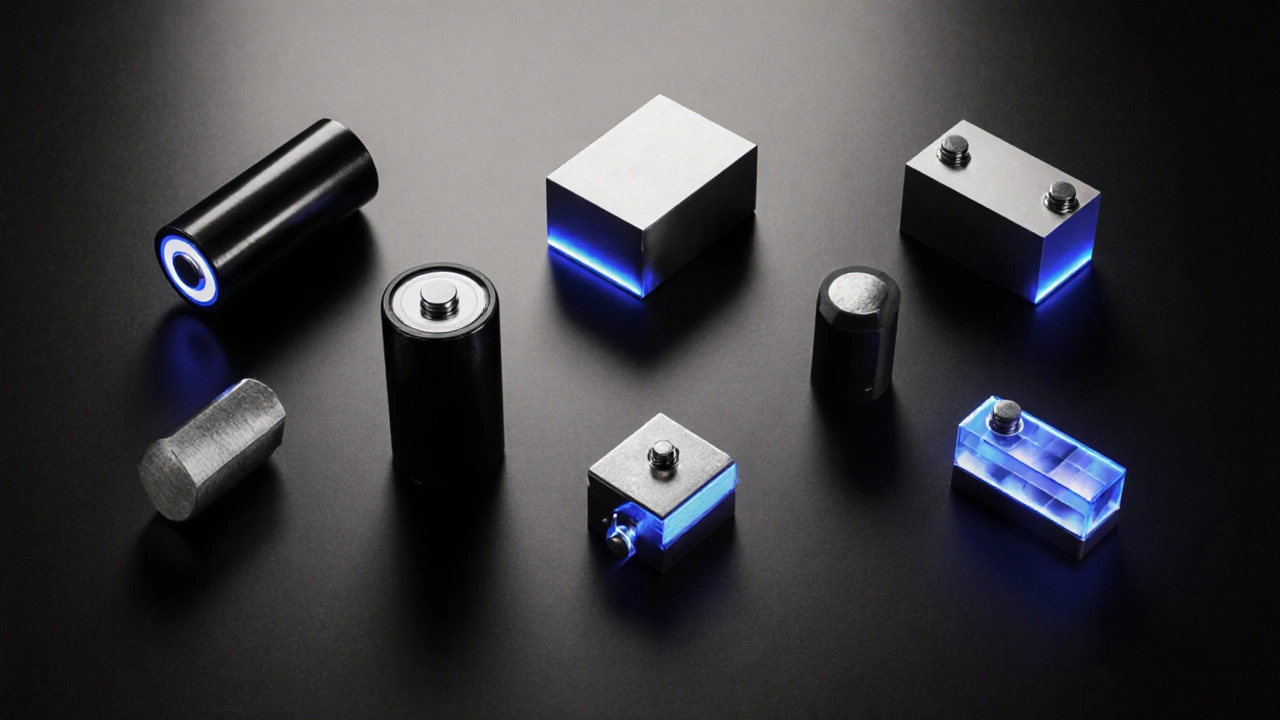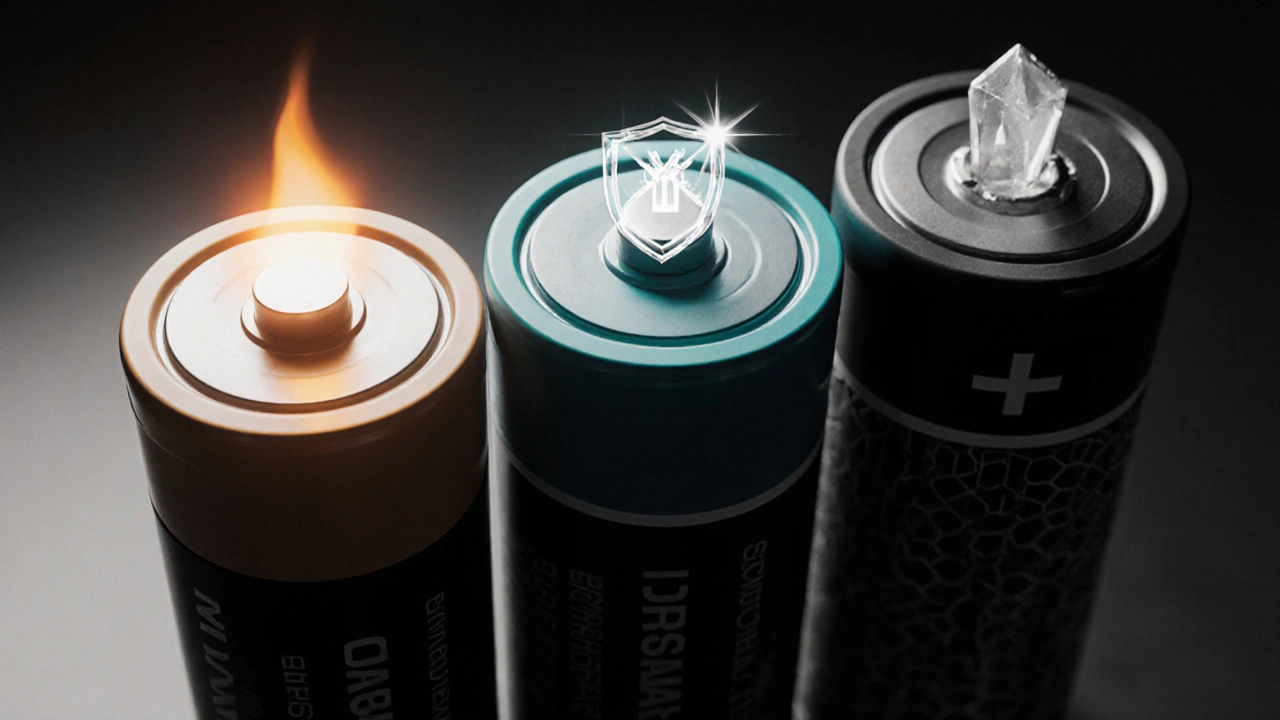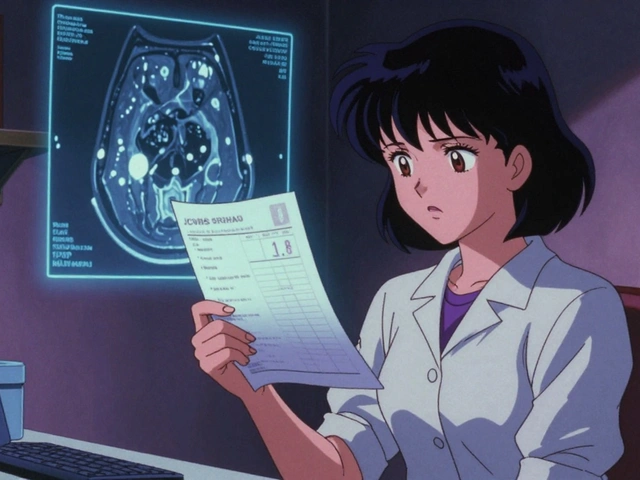
When you’re picking a power source for anything from a smartphone to an electric truck, the chemistry matters more than the brand name. Lithium battery technology has dominated the market for years, but a wave of alternatives is challenging its supremacy. This article breaks down the most common battery chemistries, compares their key metrics, and helps you decide which one fits your next project.
Key Takeaways
- Lithium‑ion offers the highest energy density but can be pricey and safety‑sensitive.
- Nickel‑Manganese‑Cobalt (NMC) balances energy and power, making it popular in EVs.
- Lithium Iron Phosphate (LFP) sacrifices some energy for longer life and lower cost.
- Solid‑state batteries promise safety and higher energy, yet remain expensive and limited in volume production.
- Sodium‑ion, Zinc‑air, and Lead‑acid serve niche markets where cost or raw‑material abundance outweighs performance.
What Is Lithium and Why It Dominates
Lithium is a soft, silvery metal that serves as the primary charge carrier in modern lithium‑ion cells. Its low atomic weight (6.94g/mol) enables high gravimetric energy density, while its electrochemical potential (≈‑3.04V vs. Li/Li⁺) drives the high voltage of lithium‑based cells. The first commercial lithium‑ion battery launched in 1991, and since then it fuels everything from smartphones to aerospace applications.
Major Alternatives at a Glance
Below are the leading chemistries that compete with traditional lithium‑ion:
- Nickel‑Manganese‑Cobalt (NMC) A lithium‑based cathode mix that blends nickel, manganese, and cobalt to improve energy density and power delivery.
- Lithium Iron Phosphate (LFP) Uses iron phosphate as the cathode material, offering excellent thermal stability and long cycle life.
- Solid‑State Battery Replaces the liquid electrolyte with a solid ceramic or polymer, boosting safety and potentially energy density.
- Sodium‑Ion Employs sodium ions instead of lithium, leveraging abundant raw material and lower cost.
- Zinc‑Air Uses zinc metal as the anode and oxygen from air as the cathode, achieving very high theoretical energy density.
- Lead‑Acid The oldest rechargeable battery, valued for its low cost and recyclability despite heavy weight.
- Graphene‑Enhanced Battery Integrates graphene sheets into electrodes to improve conductivity and charge speed.
Side‑by‑Side Comparison
| Technology | Energy Density (Wh/kg) | Cycle Life (full cycles) | Safety | Cost (USD/kWh) | Typical Applications |
|---|---|---|---|---|---|
| Lithium‑Ion (NMC) | 250‑300 | 1500‑2000 | Moderate - requires BMS | ≈$130 | EVs, portable electronics |
| LFP (Lithium‑Iron Phosphate) | 150‑170 | 3000‑5000 | High - thermally stable | ≈$90 | Grid storage, low‑speed EVs |
| Solid‑State | 350‑400 | 2000‑3000 | Very high - no flammable liquid | ≈$250+ | Premium EVs, aerospace |
| Sodium‑Ion | 120‑150 | 1000‑1500 | High - similar to Li‑ion | ≈$80 | Stationary storage, low‑cost EVs |
| Zinc‑Air | 300‑400 (theoretical) | 500‑800 | High - air‑cathode reduces heat | ≈$70 | Hearing aids, niche drones |
| Lead‑Acid | 30‑40 | 200‑500 | Low - heavy and can emit gases | ≈$50 | Backup power, starter motors |
| Graphene‑Enhanced | 200‑250 (lab) | 1500‑2500 | High - fast charge, low heat | ≈$150 | High‑performance wearables |

Performance Deep Dive
Energy density is the headline metric for portable devices, but real‑world use also depends on how quickly a cell can charge and how many cycles it survives. Lithium‑ion NMC scores high on both fronts, delivering 300Wh/kg and supporting a 0‑80% charge in 30minutes for many modern EVs. LFP, while lower at ~160Wh/kg, can handle 3,000‑plus cycles, making it a favorite for solar‑plus‑storage installations where replacement cost matters.
Solid‑state batteries push the envelope to 400Wh/kg and virtually eliminate the risk of thermal runaway because the electrolyte is non‑flammable. The trade‑off is manufacturing complexity; current pilot lines can’t yet hit the cost target of under $200/kWh needed for mass market adoption.
Sodium‑ion cells sit at the sweet spot of cost and safety. Their half‑cell voltage (~2.3V) leads to lower energy density, yet the abundance of sodium - an element 2,300 times more plentiful than lithium - keeps raw‑material prices in check. For large‑scale grid storage, the modest 150Wh/kg is acceptable when combined with a cycle life of around 1,500.
Zinc‑air’s theoretical energy (≈400Wh/kg) remains mostly untapped because the oxygen reduction reaction is hard to manage at high currents. However, recent catalyst breakthroughs have made low‑power devices like hearing aids viable, where weight is critical.
Lead‑acid’s legacy strength lies in its recyclability (over 95% reclaimed) and low upfront cost, but its 35Wh/kg figure makes it obsolete for anything beyond heavy‑duty starters or uninterruptible power supplies.
Graphene‑enhanced electrodes improve conductivity, allowing faster charge rates (up to 10C in lab settings) without the heat penalties seen in conventional lithium‑ion. Though still in early commercialization, these cells target premium wearables and drones that need rapid turnaround.
Safety and Environmental Impact
Thermal runaway is the primary safety concern for lithium‑ion packs. A breached cell can reach >500°C within seconds, igniting adjacent cells. Manufacturers therefore embed Battery Management Systems (BMS) that monitor voltage, temperature, and current.
Solid‑state electrolytes mitigate this risk dramatically because they are non‑flammable and can operate at higher temperatures without degradation. LFP also enjoys better thermal stability, often passing ignition tests at 300°C.
In terms of raw‑material sustainability, lithium mining is water‑intensive and concentrates in a few regions (Australia, Chile, China). Cobalt, another key component of many lithium chemistries, raises ethical concerns due to mining practices in the Democratic Republic of Congo. Alternatives like sodium‑ion and zinc‑air bypass these issues entirely, using abundant, low‑impact elements.
Recycling infrastructure for lithium‑ion is improving, with processes that recover up to 95% of cathode material. Lead‑acid remains the most recycled battery type, while solid‑state and graphene technologies are still developing their end‑of‑life pathways.
Cost Considerations
From a total‑cost‑of‑ownership perspective, you need to weigh upfront price against lifespan and efficiency. A $130/kWh lithium‑ion pack may cost more initially than a $90/kWh LFP pack, but if the LFP’s longer cycle life translates to fewer replacements, the overall expense evens out.
Solid‑state batteries currently sit above $250/kWh, limiting them to high‑margin markets like premium EVs or aerospace where performance justifies cost. Sodium‑ion, at roughly $80/kWh, is rapidly gaining interest for utility‑scale storage where budget constraints dominate.
Lastly, lead‑acid’s cheap price point ($50/kWh) masks hidden costs: heavier weight demands larger structures, and shorter life forces more frequent swaps, increasing labor.

Choosing the Right Chemistry for Your Project
Here’s a quick decision matrix:
- Need the highest energy per kilogram for a lightweight device? Lithium‑Ion (NMC) or upcoming Solid‑State cells.
- Prioritizing safety and long life for stationary storage? LFP or Sodium‑Ion.
- Operating on a tight budget with limited performance demands? Lead‑Acid or Zinc‑Air.
- Looking for rapid charging in a premium wear‑able? Graphene‑Enhanced lithium‑ion.
- Concerned about ethical sourcing and environmental impact? Sodium‑Ion or Zinc‑Air.
Match the chemistry to the metric that matters most for your use‑case, then factor in availability, regulatory compliance, and future‑proofing.
Future Outlook
Research pipelines suggest solid‑state batteries could hit $100/kWh by 2030, narrowing the gap with conventional lithium‑ion. Simultaneously, sodium‑ion manufacturers are scaling production in Europe and Asia, aiming for gigawatt‑hour capacity by 2027. Graphene electrode techniques are moving from lab to pilot lines, promising a new class of high‑power cells.
In the next decade, we’ll likely see a hybrid landscape: lithium‑ion continues to dominate consumer electronics, solid‑state takes the lead in premium EVs, and sodium‑ion or LFP dominate grid storage. Understanding the trade‑offs now will help you future‑proof your designs.
Frequently Asked Questions
What makes lithium‑ion batteries higher in energy density than other chemistries?
Lithium atoms are the lightest metal, so each ion carries less mass while still providing a high electrochemical potential. This combination yields the superior gravimetric energy (Wh/kg) that you see in lithium‑ion cells.
Are solid‑state batteries ready for commercial EVs?
They are still in early production stages. Pilot lines can make small batches, but mass‑production volume and cost targets haven’t been met yet. Expect limited rollout in high‑end models by 2027‑2028.
How does the cycle life of LFP compare to NMC?
LFP cells typically endure 3,000‑5,000 full cycles, while NMC cells range from 1,500‑2,000. This makes LFP a better choice for applications where the battery is cycled daily over many years.
Is sodium‑ion safe for indoor energy storage?
Yes. Sodium‑ion uses a similar liquid electrolyte to lithium‑ion, so its thermal behavior is comparable. The bigger advantage is that sodium is non‑toxic and plentiful, reducing supply‑chain concerns.
Can I recycle graphene‑enhanced batteries the same way as regular lithium‑ion?
Current recycling streams treat them as standard lithium‑ion because the graphene is integrated into the electrode matrix. Specialized facilities are developing to recover the graphene, but it’s not yet a mainstream process.





15 Comments
When you think about battery chemistry, the story isn’t just about volts and amp‑hours, it’s about the whole ecosystem that powers our daily lives. From smartphones that fit in pockets to trucks that haul cargo across continents, the choice of chemistry decides how long you stay unplugged and how safe you feel. Lithium‑ion NMC still reigns supreme for high‑energy applications, but its reliance on scarce cobalt raises both cost and ethical concerns. On the other hand, LFP gives you a rock‑solid safety record and a cycle life that can outlast the warranty on most gadgets. Solid‑state promises a future where fire‑hazard worries vanish, yet the manufacturing hurdles keep the price tag sky‑high. Sodium‑ion steps in as the humble underdog, using an element that’s practically everywhere, making it an attractive option for stationary storage where weight isn’t critical. Zinc‑air dazzles with a theoretical energy density that looks amazing on paper, but the current handling challenges keep it niche. Lead‑acid, despite its old‑school reputation, still saves the day in backup power because you can’t beat $50/kWh for a simple, recyclable solution. Graphene‑enhanced cells are the new kids on the block, offering rapid charge rates that could change how we think about wearables and drones. The key is to match the chemistry to your specific metric: whether it’s weight, cost, safety, or lifespan, there’s a battery that fits the bill. Remember that the total cost of ownership includes not just the upfront price, but also replacement frequency and efficiency losses over time. If you’re building a solar‑plus‑storage system, LFP’s long cycle life might save you a fortune in replacements. For an electric sports car, the high energy density of NMC or a future solid‑state could be worth the premium. And if you’re designing a cheap, robust backup for a rural clinic, lead‑acid still has a role to play. So, before you pick the cheapest per kWh, ask yourself which performance characteristic matters most for your project and let that guide your chemistry choice. The landscape is already shifting, and staying informed will keep your designs future‑proof.
OMG, reading this felt like a rollercoaster through the battery world! 🎢 Lithium‑ion is still the rockstar, but have you seen the hype around solid‑state? It's like the superhero that hasn't gotten its cape yet. LFP is the trusty sidekick-reliable, low‑maintenance, and never gets that drama‑queen fiery vibe. Sodium‑ion? That's the underdog that might just steal the show when we need cheap, massive storage for the grid. And I can't even start on zinc‑air, it's like the secret weapon in hearing aids-tiny but mighty! The best part is seeing how each chemistry plays into real life, from sleek phones to hulking trucks. Keep an eye on graphene‑enhanced cells too; they might just make your smartwatch charge in minutes. Seriously, the future looks electrifying! ✨
Lithium‑ion NMC excels in energy density but suffers from cobalt supply issues.
Totally agree that safety and lifespan often outweigh chasing the highest Wh/kg for many projects. LFP’s thermal stability makes it a solid pick for stationary storage, especially when you factor in the lower replacement cost over a decade. Also, the recycling infrastructure for LFP is improving, which adds an environmental plus.
While the data presents a balanced view, one must not ignore the geopolitical ramifications of lithium and cobalt extraction. The concentration of these critical minerals in a handful of nations creates a strategic vulnerability that could be exploited by malicious actors seeking to manipulate supply chains. Moreover, the alleged “green” narrative of electric vehicles is a veneer that conceals the environmental degradation caused by open‑pit mining and the toxic runoff that contaminates local water sources. Stakeholders should therefore demand transparent sourcing and invest heavily in truly sustainable alternatives such as sodium‑ion or zinc‑air, which do not rely on contested resources. Failure to act now will inevitably entrench a new form of resource colonialism.
The interplay of thermodynamics and materials science in battery design is nothing short of poetic. When you consider the lattice structures that allow lithium ions to shuttle back and forth, it feels like a meticulously choreographed ballet. Yet, the practical constraints-cost, safety, raw‑material availability-anchor that elegance in the real world. It’s a reminder that every breakthrough is a negotiation between ideal physics and gritty economics. So, while we celebrate the lofty energy densities of solid‑state prototypes, let’s not dismiss the quiet reliability of LFP, which quietly fuels countless renewable installations.
Great point on cycle life, especially for grid‑scale storage. LFP often outlives NMC by a wide margin, reducing lifecycle costs.
Imagine a world where every electric vehicle came equipped with a solid‑state pack-no more worries about thermal runaway, instant charging, and a whisper‑quiet ride. That vision drives a lot of the excitement, but we must stay grounded; the current production volumes are still tiny, and the costs remain prohibitive for mass‑market adoption. In the meantime, LFP is quietly taking over bus fleets because the trade‑off in energy density is acceptable when the vehicle’s range is constrained by duty cycles rather than sprint performance. Sodium‑ion, with its abundant raw material base, could become the workhorse for massive stationary storage, especially as utilities look to shave off the last few cents per kWh. Meanwhile, graphene‑enhanced electrodes hint at a future where our wearables can be charged in seconds without overheating-an enticing prospect for the next generation of AR glasses. So, each chemistry has a niche, and the smartest engineers will match the right tool to the specific problem rather than chasing a one‑size‑fits‑all solution.
Both solid‑state and sodium‑ion are promising, but each has distinct scaling challenges.
In the grand tapestry of energy storage, each battery chemistry weaves a unique thread. The elegance of lithium‑ion lies in its unparalleled energy density, yet its reliance on scarce resources paints a picture of vulnerability. Conversely, LFP offers a more resilient pattern, sacrificing a bit of vigor for longevity and safety. The emerging solid‑state designs hint at a future where the threads might intertwine, delivering both high energy and inherent safety. It is this balance that will ultimately define the next chapter of sustainable power.
When we talk about scalability, sodium‑ion’s abundance is a game‑changer, especially for grid applications where weight isn’t a primary concern. The lower voltage does mean you need more cells for the same output, but the overall system cost can drop significantly. LFP, on the other hand, already enjoys proven large‑scale deployments, making it a low‑risk choice for utilities. And while solid‑state shows promise, its current production bottlenecks keep it in the niche segment of premium EVs.
From a practical standpoint, I always start by listing the project's priorities: weight, cost, safety, and lifecycle. If weight is the top concern, lithium‑ion NMC usually wins. If you need something that can handle daily deep cycles for years, LFP makes sense. For a budget‑constrained stationary storage system, sodium‑ion can be a sweet spot. And when safety is non‑negotiable-think aerospace-solid‑state is the way forward despite its price tag. Matching the chemistry to the requirement helps avoid over‑engineering and keeps the project on budget.
In the tech stack of battery R&D, solid‑state is the high‑performance compute node-offers superior safety margins and can push energy density thresholds. However, the fabrication pipeline is lagging, leading to a capital‑intensive rollout. Sodium‑ion, meanwhile, is the distributed cloud-abundant raw material, lower per‑unit cost, and easier to mass produce. Graphene‑enhanced electrodes act like a specialized accelerator, slashing charge times without significant thermal penalties. Strategy should be to allocate high‑risk capital to solid‑state prototypes while leveraging sodium‑ion for bulk storage deployments.
Our nation’s energy independence depends on reducing reliance on foreign lithium and cobalt. By championing locally sourced sodium‑ion production and expanding LFP manufacturing domestically, we can keep jobs here and ensure supply chain security. This move also aligns with the broader goal of building a resilient, home‑grown green economy.
sure thing but i cant help feeling like everyone’s just hyping solid‑state because it sounds futuristic its like they wanna sell us a dream not a real solution i mean why not just put more effort into making sodium‑ion cheap and reliable instead of chasing a pipe‑dream